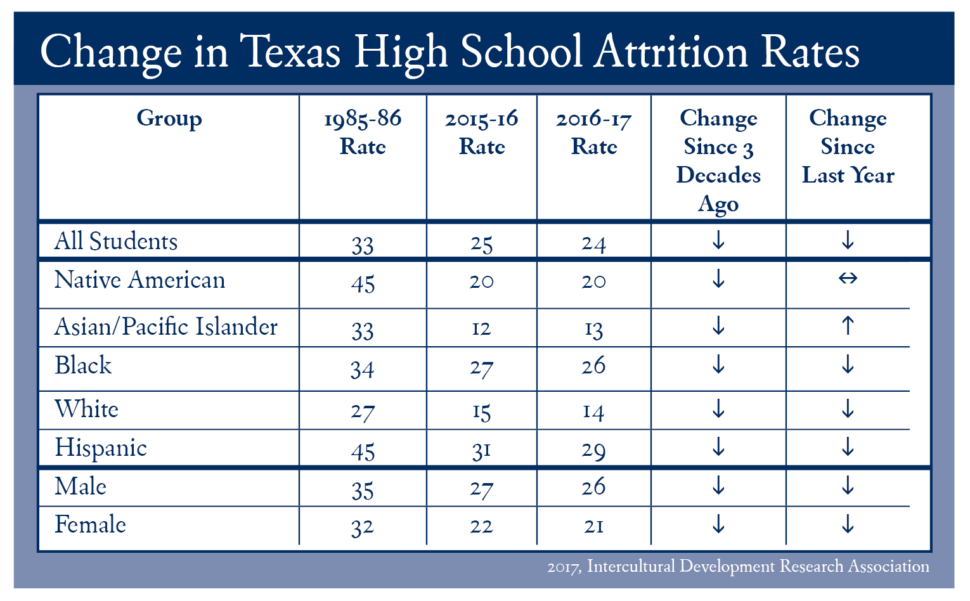• by Roy L. Johnson, M.S. • IDRA Newsletter • October 2020 •


IDRA conducted the first comprehensive study of school dropouts in Texas for the 1985-86 school year. Since comprehensive statewide data on school dropouts did not exist, IDRA developed an attrition methodology that has since become a standard method used by education researchers.
IDRA continues to conduct attrition analyses each year to assess schools’ abilities to hold on to their students until they graduate. Attrition rates are an indicator of a school’s holding power, or ability to keep students enrolled in school and learning until they graduate. In simplest terms, attrition is defined as shrinkage in size or number. Therefore, an attrition rate is the percent change in grade level enrollment between a base year and an end year.
School closures and disruptions caused by the COVID-19 pandemic may have serious implications for this year’s school dropout rates.
The 2019-20 statewide attrition rate of 20% is 13 percentage points lower than the initial rate of 33% found in IDRA’s landmark 1985-86 study and one percentage point lower than last year. The overall high school attrition rate in Texas has ranged from 20% to 25% over the past eight years.


Across racial and ethnic groups, attrition rates are lower than they were over three decades ago when IDRA conducted the first attrition study. In this year’s study, the attrition rate of each racial/ethnic group declined by one or two percentage points, except for white and Latino students whose rates stayed the same. Key findings of the latest study include the following.
Texas public schools fail to graduate one out of every five students.
- Nearly 87,000 students from the 2016-17 freshman class were lost from public high school enrollment in 2019-20.
- For the class of 2020, Latino students and Black students were two times more likely to leave school without graduating than white students.
- In four decades, the overall attrition rate declined from 33% in 1985-86 to 20% in 2019-20, which is a 39% improvement.
- The attrition rate gap between white students and Latino students decreased by 28% from 18 percentage points in 1985-86 to 13 percentage points in 2019-20.
- The attrition rate gap between white students and Black students increased by 57% from 7 percentage points in 1985-86 to 11 percentage points in 2019-20.
Due to the timing that data used in IDRA’s attrition studies are available each year from the Texas Education Agency, this year’s study does not reflect the effects of COVID-19 on schools.
School closures and disruptions caused by the COVID-19 pandemic may have serious implications for school dropout rates (Klein, 2020). In a national survey of high school students during COVID-19 pandemic, the America’s Promise Alliance (Margolius, et al., 2020) found that the pandemic has had a widespread negative impact on learning time, emotional health and social connection. The study found that over one-quarter of students reported that they felt disconnected to school adults (29%), classmates (23%), and their school community (22%).
According to Shawna De La Rosa in an article published in the Huffington Post (September 2020), some education experts believe that remote learning during COVID-19 places students at higher risk of dropping out of school. Factors include the loss of connection with peers and school support, reduction in educational services and extracurricular activities, and loss of other activities and events that help to motivate students.
IDRA conducts a forecast analysis of the expected year that the attrition rate will equal zero. Last year’s analysis – before COVID-19 – predicted that, barring significant improvements in policy and practice, Texas will continue to have attrition rates ranging from 20% to 25% and will not reach an attrition rate of zero until the year 2036-37.
Clearly, there needs to be a new sense of urgency to prevent students from dropping out of school. A review of the research on effective dropout prevention strategies, including IDRA’s own research over the past four decades, shows that certain components are vital to successful dropout prevention.
- All students must be valued.
- There must be at least one educator in a student’s life who is totally committed to the success of that student.
- Families must be valued as partners with the school, all committed to ensuring that equity and excellence are present in a student’s life.
- Schools must change and innovate to match the characteristics of their students and embrace the strengths and contributions that students and their families bring.
- School staff, especially teachers, must be equipped with the tools needed to ensure their students’ success, including the use of technology, different learning styles and mentoring programs. Effective professional development can help provide these tools.
IDRA will publish the full 2019-20 study online at www.idra.org soon. It will include methodology, historical statewide attrition rates and numbers of students lost to attrition categorized by race and ethnicity and by gender, a county-level attrition rate table, trend data by county, and historical county-level numbers of students lost to attrition. In the 2020-21 study, IDRA plans to address the impact of COVID-19 on attrition and school dropout rates.
Resources
De La Rosa, S. (September 21, 2020). Ed experts fear rise in dropouts as remote learning continues. Education Dive.
Klein, R. (September 18, 2020). Experts Predict a Big Increase in High School Dropouts Is On the Horizon. Huffington Post.
Margolius, M., Doyle Lynch, A., Pufall Jones, E. & Hynes, M. (2020). The State of Young People During COVID-19: Findings from a Nationally Representative Survey of High School Youth. Americas Promise Alliance.
Roy L. Johnson, M.S., is the IDRA Director of Evaluation. Comments and questions may be directed to him via e-mail at roy.johnson@idra.org.
[©2020, IDRA. This article originally appeared in the October 2020 IDRA Newsletter by the Intercultural Development Research Association. Permission to reproduce this article is granted provided the article is reprinted in its entirety and proper credit is given to IDRA and the author.]


